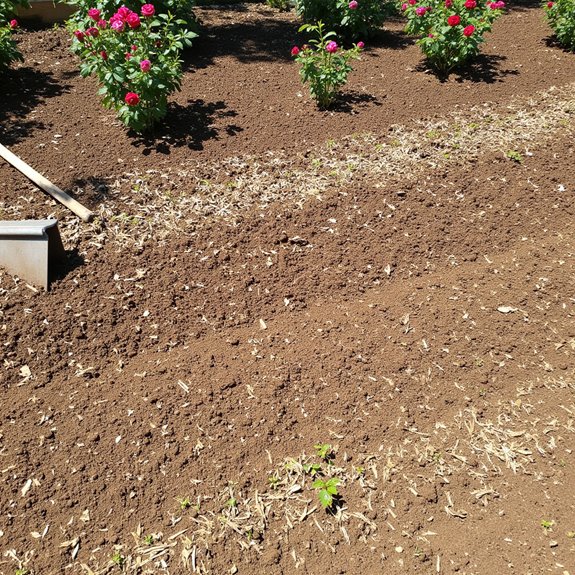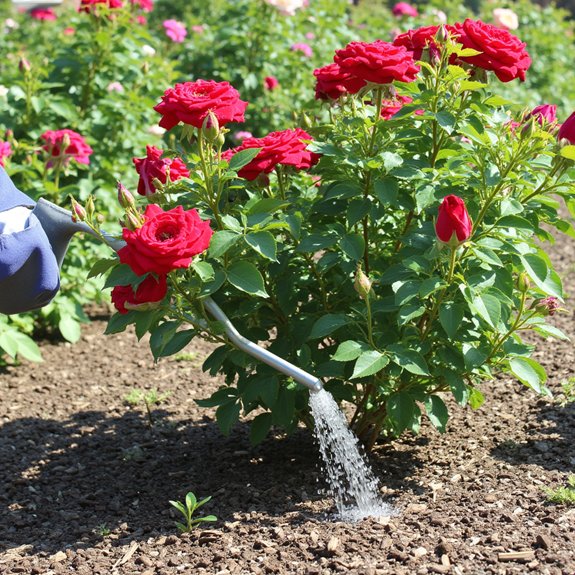Like Sleeping Beauty’s castle surrounded by thorns, your garden might be hiding the potential for breathtaking roses that seem just out of reach. You’ve probably watched neighbors effortlessly cultivate prize-winning blooms while your own attempts result in leggy stems, sparse flowers, or diseased leaves. The difference isn’t luck or natural talent—it’s knowing the specific techniques that transform ordinary rose bushes into showstoppers, and these methods are simpler than you think.
Contents
- 1 Selecting the Perfect Rose Varieties for Your Climate
- 2 Mastering the Art of Proper Rose Planting
- 3 Essential Mulching and Soil Preparation Techniques
- 4 Optimal Spacing and Support Systems for Healthy Growth
- 5 Effective Watering Strategies for Thriving Roses
- 6 Fertilization Schedules and Nutrient Management
- 7 Professional Pruning Methods for Maximum Blooms
- 8 Disease Prevention and Pest Control Solutions
- 9 Seasonal Care and Winter Protection Practices
- 10 Maximizing Beauty Through Deadheading and Bloom Maintenance
Selecting the Perfect Rose Varieties for Your Climate

Why struggle with roses that can’t handle your local weather when choosing the right variety makes all the difference? Rose variety selection starts with understanding your USDA hardiness zone, which determines which plants survive winter temperatures.
Cold climate gardeners should choose roses on their own roots, as they’re hardier than grafted varieties. Hot, humid regions need varieties resistant to black spot and mildew since these diseases thrive in moisture.
Climate compatibility means matching roses to your specific soil and environmental conditions. Research varieties bred for your area’s challenges, whether that’s drought, humidity, or freezing temperatures, ensuring long-term success.
Mastering the Art of Proper Rose Planting
Three critical timing windows determine your rose planting success: early spring, fall, or container planting during summer heat. Spring planting lets roots establish before brutal summer temperatures hit. Fall requires six weeks before frost arrives, giving adequate establishment time.
Container gardening tips include choosing terracotta pots for proper drainage, avoiding plastic when possible. Dig irregularly-shaped holes, not perfect circles, encouraging natural root expansion. Cover bud unions completely with native soil, never enriched potting mix.
Rose propagation techniques work best when you backfill carefully, preventing root coiling. Skip midsummer planting unless you’re using containers—heat stress kills new plantings quickly.
Essential Mulching and Soil Preparation Techniques

After you’ve planted your roses correctly, soil preparation becomes your foundation for stunning blooms year after year. Start with soil testing to determine pH levels between 6-6.5, which roses prefer most. Apply 3-4 inches of organic mulch around each plant, choosing from various mulch types like straw, pine needles, or wood chips. This layer conserves moisture, stabilizes soil temperature, and enriches the ground as it decomposes. Never skip mulching—it’s essential for healthy roses. Space mulch two inches from the base to prevent crown rot. Well-prepared soil with proper mulching creates the perfect environment for spectacular rose growth.
Optimal Spacing and Support Systems for Healthy Growth
When you give roses proper spacing, you’re setting the stage for healthier plants and more abundant blooms. Following proper spacing guidelines means placing most roses 2-3 feet apart, though you’ll need to check each variety’s mature size. This distance allows adequate airflow between plants, reducing disease risk while giving roots room to expand without competing for nutrients.
Climbing varieties require sturdy support structures like trellises or arbors. Train their canes horizontally rather than vertically—this encourages more flowering points along each stem. Make sure your supports can handle the weight of mature, fully-leafed plants during windy conditions.
Effective Watering Strategies for Thriving Roses

Deep, infrequent watering creates stronger roses than daily sprinkling ever could. You’ll encourage deep root development by watering thoroughly once or twice weekly instead of frequent shallow drinks. Early morning watering works best, giving plants time to absorb moisture before heat hits.
Monitor soil moisture by checking two inches down with your finger. If it’s dry, it’s watering time. Fresh plantings need more attention until established, but mature roses prefer consistency over constant coddling. Mulch helps retain moisture between sessions. Your watering frequency should match weather conditions, adjusting during hot spells or rainy periods.
Fertilization Schedules and Nutrient Management
Proper watering sets the foundation, but strategic feeding turns good roses into spectacular ones. You’ll want to start fertilizing in early spring as new growth emerges, using balanced rose fertilizers as your primary nutrient sources. Apply every 4-6 weeks throughout the growing season, but stop 6-8 weeks before first frost.
Young roses need only organic compost initially. For bare-root varieties, wait until they’ve leafed out before starting any fertilization methods. Never feed dormant plants in winter.
Container roses require more frequent feeding since nutrients leach out quickly, while established garden roses benefit from less frequent, deeper applications.
Professional Pruning Methods for Maximum Blooms
Although timing matters most, your cutting technique determines whether roses produce abundant blooms or struggle through the season. Make cuts at a 45-degree angle, about ¼ inch above outward-facing buds. This angle prevents water from pooling on cut surfaces, reducing disease risk.
Remove dead, diseased, and damaged wood first—the three D’s of pruning techniques. Cut back to healthy, white pith inside canes. Thin crowded centers to improve airflow, keeping 3-5 strongest canes on established bushes.
For bloom enhancement, cut weak growth and suckers completely. Shape plants with an open vase structure, encouraging horizontal cane training on climbers to maximize flowering points.
Disease Prevention and Pest Control Solutions
Healthy roses face fewer pest problems, but even well-pruned plants can’t escape every threat lurking in your garden. Master pest identification by checking leaves weekly for aphids, spider mites, and thrips. These tiny invaders cluster on new growth and leaf undersides.
Watch for disease symptoms like black spots on leaves, powdery white coating, or yellowing foliage. Remove infected material immediately, sanitizing your pruning shears between cuts. Water at soil level, never on leaves, to prevent fungal issues.
Choose disease-resistant varieties and encourage beneficial insects with diverse companion plantings like Nepeta and Agastache for natural pest control.
Seasonal Care and Winter Protection Practices
As autumn temperatures drop below 50°F consistently, your roses begin their natural change into dormancy, signaling it’s time to shift your care routine. Winterizing roses starts with applying 3-4 inches of mulch around the base, protecting roots from freeze-thaw cycles. Stop deadheading in late summer, allowing hips to form naturally. This tells your plants to prepare for winter rest.
Seasonal care includes reducing watering frequency as growth slows. Clean up fallen leaves and debris to minimize disease risk next spring. Container roses need extra protection, so move them to sheltered locations or wrap pots with insulation materials.
Maximizing Beauty Through Deadheading and Bloom Maintenance
While winter protection keeps your roses alive, proper deadheading keeps them thriving throughout the growing season. These deadheading techniques involve removing spent blooms by clipping stems just above the first five-leaflet leaf, or simply pinching off faded flowers with your fingers.
Regular deadheading promotes bloom promotion by redirecting the plant’s energy from seed production back into creating new buds. You’ll see fresh blooms within 4-6 weeks after deadheading.
Stop deadheading 6-8 weeks before your first expected frost. This allows hips to develop, signaling your roses to prepare for dormancy naturally.
